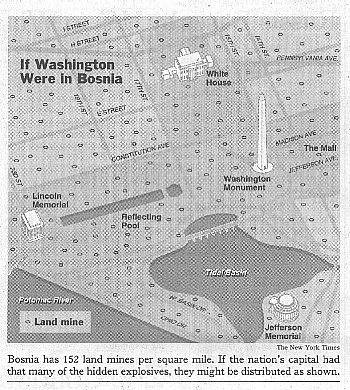Sarajevo Minefields

| ||||||

| ||||||
This year's (1997) Nobel Peace Prize was won by the International Campaign to Ban landmines (ICBL) and Jody Williams, the U.S. activists fighting for a world-wide landmines ban.
The rise to prominence of the landmines issue, particularly through the activity of the late Princess Diana, led to the U.N. campaign Landmines destroy life. The problem, of course, is in the member countries:
 USA, the largest producer of (cheap) landmines, is also the home of the largest (very expensive) demining operations, although, of course, no landmines were ever deployed on the U.S. soil. The U.S. still opposes the worldwide landmines ban, arguing that landmines are necessary for the security of the demilitarized zone between North and South Korea. To its credit the U.S. has stopped
producing it's dumb mines (the smart mines deactivate automatically after a certain time frame), though they have significant stockpiles (that have to be either sold or destroyed). Dumb mines production is taken over by China, a cherished U.S. trading partner. Former Yugoslavia was one of the most important exporters, producing 2 anti-personel mines which are considered the hardest to detect and destroy in the world (they were sold to Iraq which used them in Kuwait, so this is the opinion of the U.S. deminers - Askin & Goose, 1994), as well as the probably the best antitank mine, the TMRP 6, that can be deployed from a helicopter. Yugoslav Army had about 6 million landmines available for use before the war in Bosnia. With the present pace of mine clearing, it would take another 100 years to clear them all, according to the Landmine Survivors Rehabilitation Database. This pace may be sped up with the use of new technology of mine detection and destruction based on blimps.
USA, the largest producer of (cheap) landmines, is also the home of the largest (very expensive) demining operations, although, of course, no landmines were ever deployed on the U.S. soil. The U.S. still opposes the worldwide landmines ban, arguing that landmines are necessary for the security of the demilitarized zone between North and South Korea. To its credit the U.S. has stopped
producing it's dumb mines (the smart mines deactivate automatically after a certain time frame), though they have significant stockpiles (that have to be either sold or destroyed). Dumb mines production is taken over by China, a cherished U.S. trading partner. Former Yugoslavia was one of the most important exporters, producing 2 anti-personel mines which are considered the hardest to detect and destroy in the world (they were sold to Iraq which used them in Kuwait, so this is the opinion of the U.S. deminers - Askin & Goose, 1994), as well as the probably the best antitank mine, the TMRP 6, that can be deployed from a helicopter. Yugoslav Army had about 6 million landmines available for use before the war in Bosnia. With the present pace of mine clearing, it would take another 100 years to clear them all, according to the Landmine Survivors Rehabilitation Database. This pace may be sped up with the use of new technology of mine detection and destruction based on blimps.
 As result, today Croatia, Bosnia-Hercegovina and Kosovo have to deal with a big land-mines problem. In Kosovo, UNICEF is distributing a landmines-awareness leaflet in Albanian to children. There were disturbing news from Croatia, tough, that the government ordered removal of all landmines warning signs before the summer tourist season '98 in order to make tourists feel more safe! Fortunately, the locals did the good job of warning tourists anyway, so nobody died. In Bosnia, you can check out MEDEX: a multi-ethnic Mine Awareness Camp for children 7-17 years of age located on Pavlovica mountain in Central Bosnia, run by a non-governmental organization from Novi Travnik.
As result, today Croatia, Bosnia-Hercegovina and Kosovo have to deal with a big land-mines problem. In Kosovo, UNICEF is distributing a landmines-awareness leaflet in Albanian to children. There were disturbing news from Croatia, tough, that the government ordered removal of all landmines warning signs before the summer tourist season '98 in order to make tourists feel more safe! Fortunately, the locals did the good job of warning tourists anyway, so nobody died. In Bosnia, you can check out MEDEX: a multi-ethnic Mine Awareness Camp for children 7-17 years of age located on Pavlovica mountain in Central Bosnia, run by a non-governmental organization from Novi Travnik.
But, isn't it absolutely humiliating that the same person who commanded the siege of Sarajevo is later put in charge of demining operations in Bosnia?